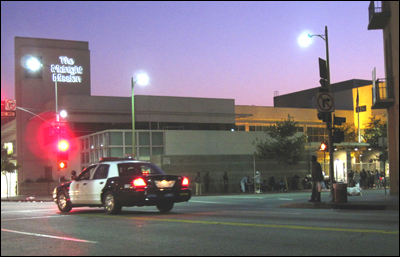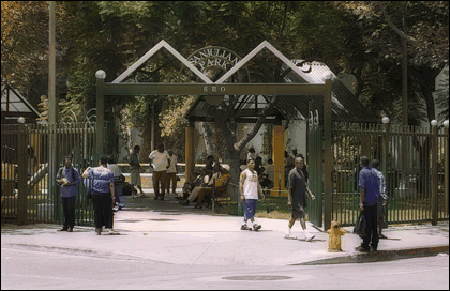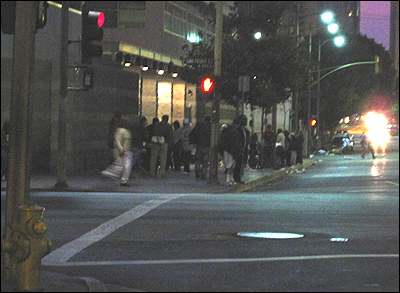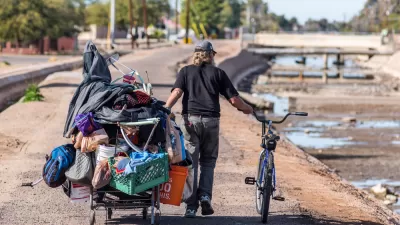To fight homelessness, some cities provide services, some build housing, and some arrest people. Often it's a combination of the three, but now many critics are calling on officials to de-emphasize the law enforcement element. Los Angeles is Ground Zero.
On any given night in America, there are about 664,000 people sleeping on the street. On that same night in Los Angeles, there are more than 40,000 -- the highest concentration of homeless people in any American city. Many of these homeless people can be found in downtown L.A.'s infamous 'Skid Row' neighborhood. This 50-square block area has been called ground zero for homelessness in the U.S. and one of the most-policed areas in the world, but the thousands bundled in sleeping bags and tents on its sidewalks every night call it home.
They've been doing it for decades, and though it's frowned upon by many in the city – from politicians to law enforcement officials to business leaders to regular residents – it is an accepted reality. The Los Angeles Police Department and the homeless population of Skid Row have a kind of informal agreement that once night falls the area becomes an unofficial campsite. Tents are left standing and occupants are allowed to sleep through the night, uninterrupted by flashlights and badges. Uninterrupted, that is, if all people are doing is sleeping. Any other illegal activity remains subject to punishment, especially since the adoption of a "zero-tolerance" enforcement policyin 2006. Particularly high numbers of citations and arrests in this part of town show that for the LAPD, to permit homeless people to sleep on public property is not to look blindly on its consequences.

A 2009 joint report from the National Coalition for the Homeless and the National Law Center on Homelessness and Poverty singled out Los Angeles as the nation's "meanest city" in terms of police enforcement of the homeless.
But a 2007 legal settlement between the city and the American Civil Liberties Union of Southern California has watered down that "zero-tolerance" policy to "some-tolerance". In the face of a 2003 lawsuit seeking to repeal a more than 40 year-old law that prohibits people from sleeping on public sidewalks, the city agreed that until it built 1,250 units of affordable housing it would not enforce the law, allowing people to sleep on public sidewalks from 9 p.m. to 6 a.m. anywhere in the city.
Allowing people to sleep legally on public sidewalks may not be the solution to homelessness, but many experts on homelessness and civil rights agree that it represents a major step towards a solution. Arresting people for sleeping on sidewalks criminalizes homelessness, and that, many say, sustains homelessness. Others argue that it is the homeless themselves who perpetuate their own situation by refusing services and remaining on the street. They say the only effective way to deal with them is by strict enforcement and institutionalization.
These represent two of the dominant ideological perspectives on the issue -- two states of mind that have shaped this country's approach to homelessness for the past three decades. But in recent years, some public officials and civic leaders have begun to question the existing models for dealing with homelessness, arguing that the persistence of the problem shows that what has been done up until now isn't working. Across the country, cities and communities are trying out new strategies to address the issue, and some of them have made significant progress and actually reduced homelessness for the first time in nearly 30 years. These new approaches have much to teach Los Angeles and other American cities that continue to struggle with homelessness today.
Updating Traditional Approaches
Philip Mangano is the former executive director of the U.S. Interagency Council on Homelessness, the agency in charge of coordinating the federal government's funding and activities to address homelessness. He's been working on homelessness issues for almost 30 years. He's seen many approaches fail, and he thinks it's time for cities to radically rethink their homeless problems.
"If what we've relied on in the past -- that is if good intentions, well-meaning programs and humanitarian gestures -- if they could end homelessness, it would have been history decades ago," said Mangano. "If punitive interventions could end homelessness, you wouldn't have any homeless people down in Skid Row."
These traditional approaches are not without merit, but many say they need an update. The LAPD updated its methods with the 2006 unveiling of Chief William J. Bratton's Safer City Initiative, an enforcement strategy that targets a few square miles in downtown L.A., including Skid Row, with 50 extra police officers and a strict focus on petty crimes, such as jaywalking, public urination and possession of drug paraphernalia. Between August 2006 and June 2009, the LAPD's Safer City Initiative Task Force made 12,630 arrests and issued 22,421 citations in the Skid Row area. The increased presence of officers has also resulted in a sharp decrease in the amount of people sleeping in Skid Row. Monthly counts conducted by the LAPD tallied 1,876 people sleeping on the streets in September 2006. By June 2009, that figure had dropped to 805.
"Before, it was a party atmosphere where they'd come from other areas and they'd encamp just because they could. It was some place to hang out," said LAPD's Jodi Wakefield, a former area captain whose command included Skid Row. "Now they don't feel comfortable just hanging out because we're very present."
Many agree the reduction is impressive, but civil rights activists question whether the Safer City Initiative really has the positive impact its results imply.
"That doesn't do anything about improving public safety or the lives of poor people," says Mark Rosenbaum, legal director of the ACLU of Southern California. "It's simply an attempt to move homeless people rather than dealing with homelessness as a social issue."
In his view, the city is simply treating homelessness as a crime, which actually does more to maintain homeless populations than to reduce them.
"Being poor has never been a crime in the United States," Rosenbaum said. "At least never formally."
Tulin Ozdeger, civil rights program director at the National Law Center on Homelessness and Poverty agrees, and lauds the city for its sidewalk sleeping settlement.
"When you punish people for doing something they need to do to survive, that violates their constitutional rights," Ozdeger said. "When you have a situation where somebody has no choice but to sleep outside because there's no place else to go, they should not be punished for doing that."
But some people think they should. Carol Schatz, president of the Central City Association of Los Angeles, is a vocal supporter of the Safer City Initiative. The downtown business group she heads represents many businesses in the Skid Row area, and it helped push forward the enforcement plan. Getting people off the streets, Schatz says, is in the best interests of not just downtown businesses, but of the homeless themselves.
"Nowhere in the country has the lawlessness, the misery, the health hazard been as acute as it is in Skid Row and downtown Los Angeles," Schatz said. "They shouldn't be allowed to be there. Period. Nobody should be living on the street."
That's a point people of all ideological slants seem to sympathize with: no one should have to live on the streets. But people are living on the streets, and many say that to get from the real to the ideal will require shifting the focus from enforcement to providing housing.
"Homelessness is really a housing issue," says Michael Stoops, executive director of the National Coalition for the Homeless. "The reason we have homelessness is we don't have enough affordable housing for people who have little or no money. So housing is the ultimate solution."
Visible Reductions and Community Preference
For the roughly 664,000 homeless people in the country every night, there are about 614,000 beds in shelters, emergency housing facilities, and permanent supportive housing programs, according to the U.S. Department of Housing and Urban Development's 2008 Annual Homeless Assessment Report to Congress. In 2006 there were just 450,000. One out of every five homeless people in the U.S. are located in L.A., Detroit or New York, according to homeless counts conducted nationwide in January 2008. Statistics indicate that 21% of L.A.'s homeless population are sheltered, a relatively low rate when compared against other big cities.
Creating more beds has been a goal of many cities, but it's a tricky task. Some vocal community members are tired of funding more beds, which many see as fuel for the fire. When weighing a plan to build shelter space that might draw more homeless to an area against a plan that arrests them and gets them off the street, many of the NIMBY-minded favor methods such as the LAPD's Safer City Initiative.
"This problem has been thirty years in the making; it's not going to be fixed in a couple of years," said Wakefield of the LAPD. "It's a continuous process and we continue to chip away here and there and make progress, first with the reduction of crime."

But Rosenbaum of the ACLU, along with other homeless activists, sees this first step of reduction as a form of criminalization that is essentially ineffective.
"I think what business interests have found out in other communities is that using law enforcement to address the issue doesn't really correct it. Homelessness isn't reduced one iota," he said. "In the end there have to be social programs and housing to deal with it. And it's just a question of how long it's going to take for the downtown businesses to appreciate that fact."
In the face of enforcement techniques that are making major reductions in the number of people camping in Skid Row, convincing the business interests downtown that this technique is not the most effective method may be challenging. Schatz of the Central City Association seems unlikely to warm up to the idea.
"There's no constitutional right to live on the street," Schatz said. "They need to be somewhere else. They need to be in some kind of a facility. Whether they want to go or not."
The High Costs of Homelessness
One way some cities have been able to bring business interests to the negotiating table has been to focus efforts on reducing the costs of homelessness to the community.
"Most cities recognize that homelessness is not a criminal problem, it's a social problem, and that even if there is not a basic humanitarian concern or a constitutional concern, even in just pure economics it's far cheaper to provide affordable housing than it is to use the jails as the city's shelter and mental health system," said Rosenbaum.
A 2004 report (PDF) from health care and human services consultants the Lewin Group found that using the criminal justice system to house homeless people costs about $65 per bed per day, compared to about $30 to provide permanent supportive housing.
"These are some of the most expensive people in the community," said Mangano. "The old status quo response to these people -- ad-hoc, uncoordinated crisis interventions -- you can't do it more expensively and you can't do it less effectively."
The 2009 joint report outlines the efforts made by some American cities to integrate business interests with the homeless populations in different communities. According to Stoops at the National Coalition for the Homeless, several cities have created programs that not only reduce the number of people sleeping on the streets, but also save money for the community.
In Portland, Oregon, officials have instituted a plan called "A Key Not a Card" that focuses on providing immediate permanent housing opportunities for people living on the street. City funding is loosely restricted, allowing participating programs to use it for rent, back rent, or security deposits, reducing some of the red tape preventing the placement of homeless people in housing quickly. In four years of operation, the program has placed more than 900 people into housing, all on a modest budget of about $2 million per year.
Broward County, Florida, has also instituted a unique program and partnership between non-profit homeless services providers and the Ft. Lauderdale Police Department that focuses policing efforts not on making arrests and citations, but rather referrals to services and shelters. Over five years, the Homeless Outreach Team has placed more than 11,000 people into shelters, and they've estimated a decline in arrests by nearly 2,500 per year.
And while these types of programs and partnerships can be encouraging for many cities, Mangano says the real innovation in handling homelessness is the countrywide explosion of broadly focused and comprehensive 10-year plans to end homelessness. More than 355 cities and counties across the country – from Akron, Ohio, to Miami, Florida, to Yonkers, New York -- have created these plans, and Mangano says success is already being seen. Essential to their success is the somewhat new ideological approach of addressing homelessness from a business perspective.
"For twenty years we looked at homeless people through a social service lens, and when we looked through that frame we saw homeless people and we wondered 'how can we serve them?' And for 20 years, that's what we did. We served them on the streets, we served them in shelters, we served them in programs," Mangano said. "Well, in the last five years, to that social service frame we've added a business frame."
Results-Driven Programs and 10-Year Plans
Mangano says that a mindshift has taken place among experts and homeless activists towards this approach, refocusing efforts on results-driven programs. Too often in the past, he says, money was just dumped into various programs that did little more than maintain homelessness. This money was essentially wasted. But the paradigm is shifting away from these money-pit programs towards programs that are looked at as investments, such as the 10-year plan to end homelessness. And these programs are investments from which lenders -- cities, businesses, residents -- expect returns.
Revisioning the solution to homelessness as a business plan has shown success for many of America's biggest cities. Mangano says that over the last three years, rates of homelessness have dropped all across the country. More than 40 cities have seen their first reductions in homeless populations in more than 25 years. New York saw a reduction of 13%, Miami saw a drop of 40%, and Portland, Oregon, experienced a decrease of nearly 70%. Creating benchmarks, goals and specific targets has helped these cities to make addressing homelessness more manageable. These successful cities have much to teach the rest of the country and much to learn from each other, according to Mangano.
"The best cities steal the best ideas then nuance them to fit their own community," Mangano said. "We call it the art of legitimate larceny."
According to Mangano and Stoops, a little "legitimate larceny" may be just what L.A. needs. The city does have a 10-year plan, which was set up during the administration of former Mayor James Hahn in the early 2000s, but officials call it "unworkable". Current Mayor Antonio Villaraigosa has made the creation of a new 10-year plan one of the priorities of his administration, but its development has been tied up over deliberations about geographic boundaries. According to Deputy Mayor for Housing and Economic Development Policy Helmi Hisserich, the city is hoping to learn from the mistakes it made with its first 10-year plan – mainly that it was trying to do too much.

"We are engaged in a discussion about how to do a 10-year plan, what is the right 10-year plan to pursue -- is it a City of Los Angeles plan? Or is it a plan that is multiple plans within communities in Los Angeles? That conversation is still taking place," Hisserich said.
But the lack of an updated and workable plan is not holding the city back from trying to address its homelessness problem, according to Hisserich, who says the city's efforts in the last two years have shifted towards the "Housing First" approach – a method focusing on the development of permanent supportive housing.
Since July 2005, 1,078 units of homeless-serving housing have been funded in Los Angeles, including 617 in 2008 alone. Last year, the city made available $99.7 million for the development of these units. Of the 1,078 units funded since 2005, 242 are complete. With more than 40,000 homeless people in the city, 242 units might not sound too impressive. But the city sees their creation as one of many important steps on a long road. Hisserich hopes to maintain the city's current momentum through the gradual development of similar individual efforts, eventually compiling them into the city's new 10-year plan.
"Unfortunately we're stuck with a plan we don't like. So we're going to try to figure out how to redo it – without stopping to plan. We can't continue to always be in the planning mode," Hisserich said. "We're trying to act."
Stoops says the recent settlement allowing people to sleep on the sidewalks is a leverage point that will move the city away from its strict enforcement policy, and possibly towards a more integrated collaboration between the city, its businesses, homeless services, law enforcement and the people on the streets.
"In reality, there's a war going on in downtown America between the forces of economic development and tourism versus visible homeless people, and in cities across the country this has been going on for twenty years," Stoops said. When cities realize how much homelessness costs the community in terms of dollars, Stoops says, it will be much easier to create the political will to divert funds from what many see as ineffective enforcement strategies.
Ozdeger at the National Law Center on Homelessness and Poverty agrees, but says cities are not moving quickly enough in this direction.
"This realization that it does cost cities a lot more to have people living out on the streets is a slow one. It's starting to spread around the country, but cities have not necessarily acted upon this revelation in a rational way," Ozedeger said.
What these experts are beginning to agree upon is that the status quo of the last 30 years is not working. New ideas and new approaches have been embraced on all sides of the issue, and many say that based on their early successes, the end of homelessness is feasibly within reach. But depending on the dominant ideology in place, the "end of homelessness" may be zero people sleeping on the streets in one particular area, or it may be all the homeless people locked up in a treatment facility, or it may be all the homeless people housed comfortably with access to health and job services as needed and desired. The end-point of each of these solutions is as varied as the techniques used to get there. But what some cities are learning is that combining these ideological approaches capitalizes on the most effective methods each has to offer.
"That approach that's results-oriented, based on things that work, helps to mitigate the NIMBY issues," Mangano said. "It won't eliminate it completely, but it gives reassurances to some of the opinion leaders in communities that finally, after 20 years of wandering in the wilderness, there's something that is working. There's a promised land of sorts for homeless people and communities to remedy what seemed to be one of the most vexing social problems."
Nate Berg is assistant editor of Planetizen.

Maui's Vacation Rental Debate Turns Ugly
Verbal attacks, misinformation campaigns and fistfights plague a high-stakes debate to convert thousands of vacation rentals into long-term housing.

Planetizen Federal Action Tracker
A weekly monitor of how Trump’s orders and actions are impacting planners and planning in America.

In Urban Planning, AI Prompting Could be the New Design Thinking
Creativity has long been key to great urban design. What if we see AI as our new creative partner?

King County Supportive Housing Program Offers Hope for Unhoused Residents
The county is taking a ‘Housing First’ approach that prioritizes getting people into housing, then offering wraparound supportive services.

Researchers Use AI to Get Clearer Picture of US Housing
Analysts are using artificial intelligence to supercharge their research by allowing them to comb through data faster. Though these AI tools can be error prone, they save time and housing researchers are optimistic about the future.

Making Shared Micromobility More Inclusive
Cities and shared mobility system operators can do more to include people with disabilities in planning and operations, per a new report.
Urban Design for Planners 1: Software Tools
This six-course series explores essential urban design concepts using open source software and equips planners with the tools they need to participate fully in the urban design process.
Planning for Universal Design
Learn the tools for implementing Universal Design in planning regulations.
planning NEXT
Appalachian Highlands Housing Partners
Mpact (founded as Rail~Volution)
City of Camden Redevelopment Agency
City of Astoria
City of Portland
City of Laramie





























